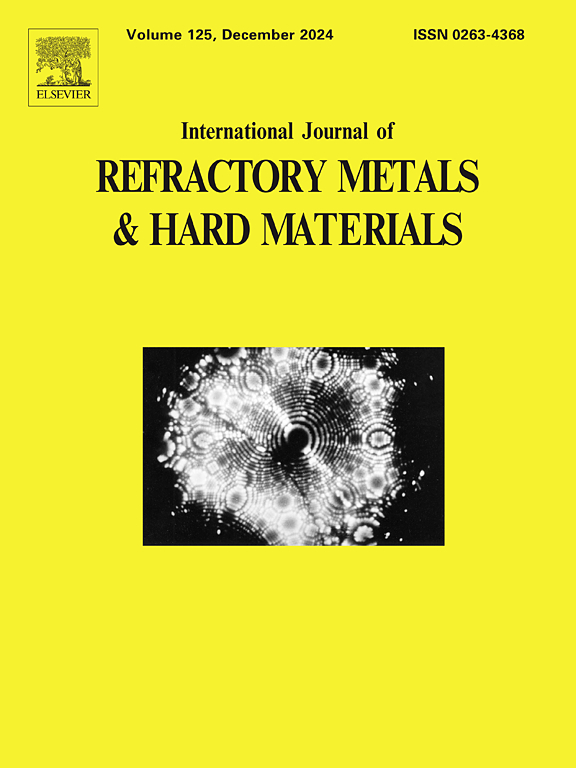Hot wear resistance of Cu/Ti2SnC composite wire
IF 4.6
2区 材料科学
Q2 MATERIALS SCIENCE, MULTIDISCIPLINARY
International Journal of Refractory Metals & Hard Materials
Pub Date : 2025-07-16
DOI:10.1016/j.ijrmhm.2025.107337
引用次数: 0
Abstract
This work investigated the hot wear resistance of Cu/Ti2SnC composite wire. Scanning electron microscope, optical microscope, and electron back-scattered diffraction (EBSD) were used. The wear test was done at temperatures of 250 °C and 400 °C. By decreasing the reinforcement content, the grain size increased and then decreased but the texture became stronger due to the higher strain. The strong texture influenced the strength and by increasing the reinforcement content, the yield and tensile strength increased and reached 297.8 MPa and 490.3 MPa, respectively, for the wire with 6 vol% Ti2SnC which contained strengthening mechanisms of dislocation hardening and load transfer. At the hot wear test, the 6-vol% Ti2SnC wire showed better wear resistance than the pure copper wire due to the proper load transfer of Ti2SnC particles and the formation of a more mechanical mixture layer (MML). The formed MML caused by the interaction of the wire interface with small debris on the disk interface, provided more protection. The worn SEM images showed that the main wear mechanisms of the extruded wires were adhesion, abrasion, delamination, and oxidation.
Cu/Ti2SnC复合丝的热磨损性能
本文研究了Cu/Ti2SnC复合丝的耐热磨损性能。采用扫描电镜、光学显微镜、电子背散射衍射(EBSD)等方法进行观察。在250°C和400°C的温度下进行磨损试验。随着增强量的减小,晶粒尺寸先增大后减小,但由于应变的增大,织构逐渐变强。强织构影响强度,随着强化量的增加,含6vol % Ti2SnC的丝的屈服强度和抗拉强度分别达到297.8 MPa和490.3 MPa,强化机制为位错硬化和载荷传递。在热磨损试验中,6 vol% Ti2SnC丝的耐磨性优于纯铜丝,这是由于Ti2SnC颗粒的载荷传递适当,形成了更机械的混合层(MML)。所形成的MML是由导线界面与磁盘界面上的小碎片相互作用造成的,提供了更多的保护。磨损的SEM图像表明,挤压丝的主要磨损机制为粘附、磨损、剥离和氧化。
本文章由计算机程序翻译,如有差异,请以英文原文为准。
求助全文
约1分钟内获得全文
求助全文
来源期刊
CiteScore
7.00
自引率
13.90%
发文量
236
审稿时长
35 days
期刊介绍:
The International Journal of Refractory Metals and Hard Materials (IJRMHM) publishes original research articles concerned with all aspects of refractory metals and hard materials. Refractory metals are defined as metals with melting points higher than 1800 °C. These are tungsten, molybdenum, chromium, tantalum, niobium, hafnium, and rhenium, as well as many compounds and alloys based thereupon. Hard materials that are included in the scope of this journal are defined as materials with hardness values higher than 1000 kg/mm2, primarily intended for applications as manufacturing tools or wear resistant components in mechanical systems. Thus they encompass carbides, nitrides and borides of metals, and related compounds. A special focus of this journal is put on the family of hardmetals, which is also known as cemented tungsten carbide, and cermets which are based on titanium carbide and carbonitrides with or without a metal binder. Ceramics and superhard materials including diamond and cubic boron nitride may also be accepted provided the subject material is presented as hard materials as defined above.

 求助内容:
求助内容: 应助结果提醒方式:
应助结果提醒方式:


